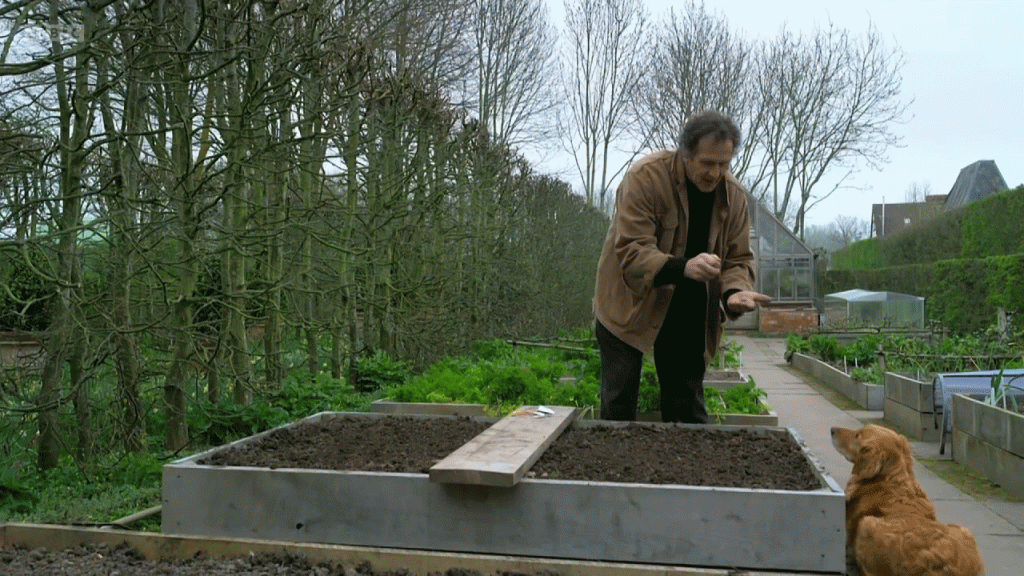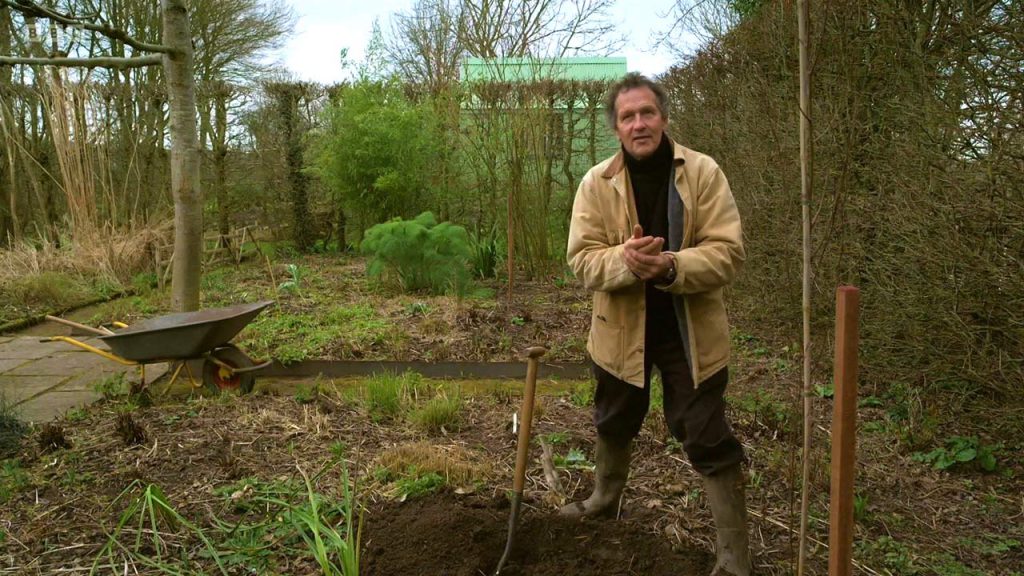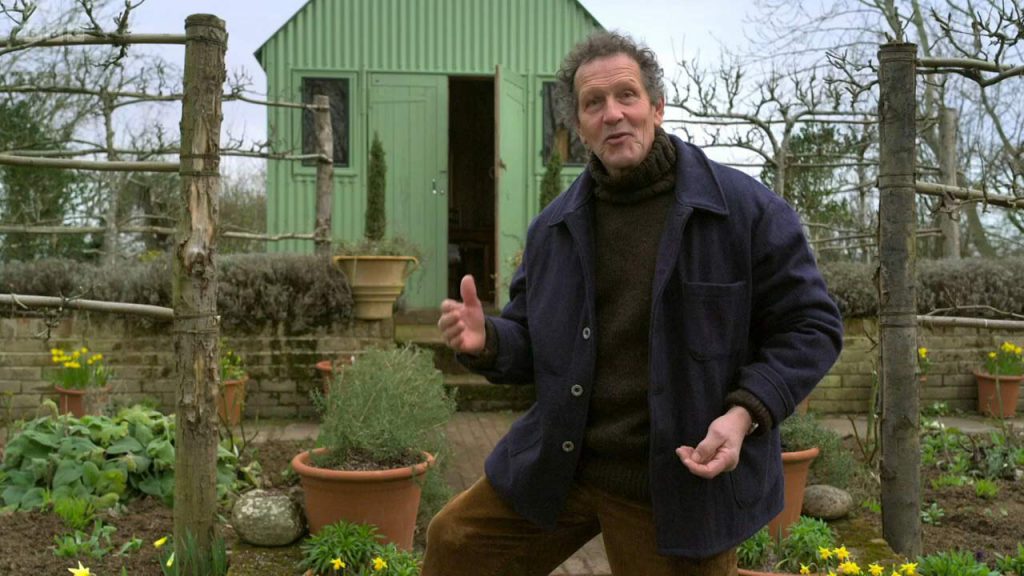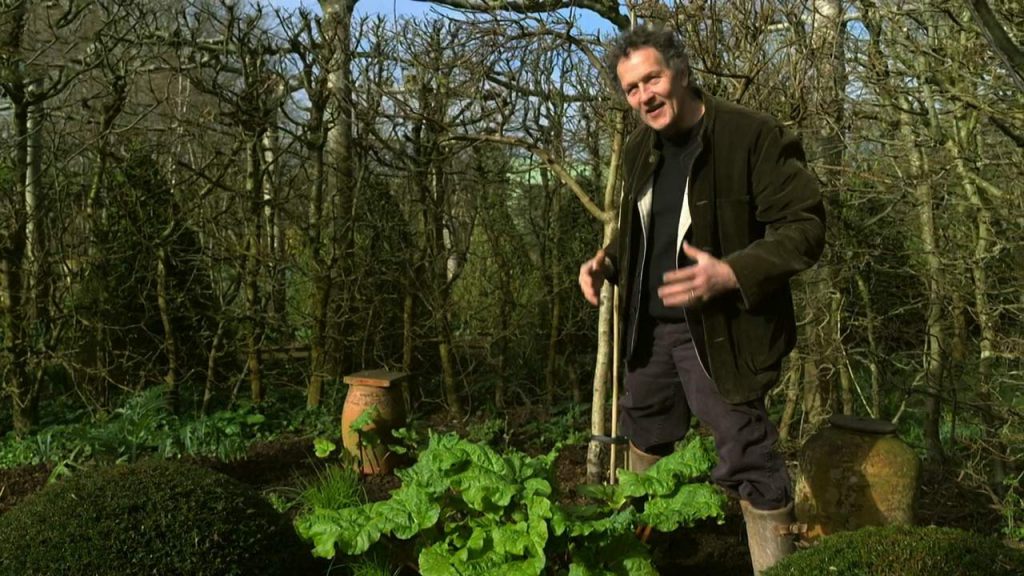Gardeners’ World 2022 episode 5 – Monty Don is enthusiastically continuing his work in the newly expanded orchard beds, meticulously planting a variety of perennials. Meanwhile, he embarks on an innovative redesign of the dry garden, showcasing his horticultural expertise. In another corner of the gardening world, Toby Buckland delves into the rich history and stunning diversity of heritage daffodils at the Cotehele estate in Cornwall, a visual feast for flower enthusiasts.
In Scotland, JJ Chalmers invites us into his world, sharing his hands-on approach to tackling various seasonal gardening tasks, bringing a personal touch to his outdoor space.
The tour doesn’t stop there. We’re whisked away to Birmingham, where an inventive couple has transformed their garden into a mesmerizing living art gallery. This unique space is meticulously arranged with an array of cacti, ferns, and air plants, each contributing to a cohesive and artistically driven design ethos.
Our journey through the realms of dedicated gardeners continues in Hertfordshire. Here, a passionate pelargonium grower welcomes us into her sanctuary, boasting an impressive collection of over 600 plants. Her devotion and expertise shine through in the meticulous care and diverse varieties she nurtures.
Finally, we turn to the heartwarming stories from Gardeners’ World viewers. Across the nation, these gardening aficionados share their personal achievements, inspiring projects, and the joy they find in cultivating their own little pieces of nature. This segment not only highlights individual gardening journeys but also fosters a sense of community among those who share a love for gardening.
Gardeners’ World 2022 episode 5
Creating a dry garden
Climate change is likely to bring with it hotter, drier summers. Consider using plants that will cope with dry soil and no additional watering. Most of the plants that tolerate dry conditions also revel in the sun so the ideal site is south or west facing, with little or no shade. Such plants also hate cold, wet soil so the ground should be free-draining. If your soil is naturally wet or cold and heavy, then you may need to build raised beds and incorporate gritty sand into the planting area to improve drainage.
Drought tolerant plants generally have low nutrient needs. Do not add any extra fertiliser as this can encourage lush growth which then needs more water in summer and is more easily damaged by frost in winter. Drought tolerant plants tend to share a range of characteristics that help them conserve moisture so that they can cope in areas of low rainfall.
Sarracenia purpurea
Sarracenia purpurea, the purple pitcher plant, northern pitcher plant, turtle socks, or side-saddle flower, is a carnivorous plant in the family Sarraceniaceae. S. purpurea is an evergreen, semi-erect, insectivorous perennial to 30cm tall. Squat, green pitchers, to around 15cm long, are flushed and veined purplish-red, have a large lip and an erect, frilled lid. Five-petalled, purple flowers, up to 5cm in diameter, are borne well above the pitchers in spring
Like other species of Sarracenia, S. purpurea obtains most of its nutrients through prey capture. However, prey acquisition is said to be inefficient, with less than 1% of the visiting prey captured within the pitcher. Even so, anecdotal evidence by growers often shows that pitchers quickly fill up with prey during the warm summer months. Prey fall into the pitcher and drown in the rainwater that collects in the base of each leaf.
Prey items, such as flies, ants, spiders, and even moths or hornets, are then digested by an invertebrate community, made up mostly by the mosquito Wyeomyia smithii and the midge Metriocnemus knabi. The relationship between W. smithii and S. purpurea is an example of commensalism.
Protists, rotifers (including Habrotrocha rosa), and bacteria form the base of inquiline food web that shreds and mineralizes available prey, making nutrients available to the plant. New pitcher leaves do produce digestive enzymes such as hydrolases and proteases, but as the individual leaves get older into their second year, digestion of prey material is aided by the community of bacteria that live within the pitchers.
Anemone – Gardeners’ World 2022 episode 5
Anemone (/əˈnɛməniː/) is a genus of flowering plants in the buttercup family Ranunculaceae. Plants of the genus are commonly called windflowers. They are native to the temperate and subtropical regions of all continents except Australia, New Zealand and Antarctica. The genus is closely related to several other genera including Anemonoides, Anemonastrum, Hepatica, and Pulsatilla. Some botanists include these genera within Anemone.
Anemone are perennials that have basal leaves with long leaf-stems that can be upright or prostrate. Leaves are simple or compound with lobed, parted, or undivided leaf blades. The leaf margins are toothed or entire. Flowers with 4–27 sepals are produced singly, in cymes of 2–9 flowers, or in umbels, above a cluster of leaf- or sepal-like bracts. Sepals may be any color. The pistils have one ovule. The flowers have nectaries, but petals are missing in the majority of species.
The fruits are ovoid to obovoid shaped achenes that are collected together in a tight cluster, ending variously lengthened stalks; though many species have sessile clusters terminating the stems. The achenes are beaked and some species have feathery hairs attached to them.
Cultivating a Resilient Garden: Innovative Approaches to Gardening in 2023
Embracing Dry Gardens: Adapting to Climate Change
The Need for Drought-Resilient Gardening
With the increasing likelihood of hotter, drier summers due to climate change, creating a dry garden has become more relevant than ever. Such gardens are not only practical but also contribute to environmental sustainability. Ideal for areas with limited water resources, dry gardens feature plants that thrive in arid conditions, requiring minimal watering. When planning a dry garden, it’s essential to select a site that receives ample sunlight, preferably south or west-facing. Drainage is crucial; therefore, if your soil is naturally moist or heavy, consider constructing raised beds and amending the soil with gritty sand to improve drainage.
Plant Selection for Dry Gardens
Choosing plants for a dry garden involves selecting species that can withstand arid conditions. These plants typically require low nutrients and should not be over-fertilized, as this can lead to excessive growth that demands more water. Drought-resistant plants often share characteristics like deep root systems and waxy or hairy leaves, which help in water conservation. Incorporating such plants not only ensures a garden that can thrive with minimal water but also adds a unique aesthetic to your outdoor space.
Sarracenia Purpurea: A Unique Carnivorous Plant
An Overview of Sarracenia Purpurea
Sarracenia purpurea, commonly known as the purple pitcher plant, is a fascinating addition to any garden, especially for those interested in carnivorous plants. This perennial is known for its striking pitchers and vibrant purple flowers. The pitchers, which are modified leaves, trap and digest insects, playing a crucial role in the plant’s nutrient acquisition. Interestingly, this process involves a symbiotic relationship with invertebrates like the mosquito Wyeomyia smithii, which helps in breaking down the prey.
Growing and Caring for Sarracenia Purpurea
When growing Sarracenia purpurea, it’s essential to mimic its natural boggy habitat. This means ensuring consistently moist soil and high humidity. The plant prefers full sun, which helps in the development of its characteristic pitchers. While it’s a low-maintenance plant, understanding its unique needs is key to successful cultivation.
Anemone: The Versatile Perennial
Characteristics and Varieties of Anemones
Anemones, part of the buttercup family, are a diverse group of plants offering a range of colors and forms. These perennials are known for their delicate flowers and can vary from upright to prostrate growth habits. Anemones are ideal for adding a burst of color to your garden, and their adaptive nature makes them suitable for various garden settings.
Planting and Maintenance
Planting anemones involves considering the specific needs of the variety you choose. They generally prefer well-draining soil and can thrive in both sun and partial shade. Regular watering and occasional fertilizing will keep these flowers vibrant throughout their blooming season. Their ease of care makes them a favorite among both novice and experienced gardeners.
Frequently Asked Questions – Gardeners’ World 2022 episode 5
What are the best plants for a dry garden?
Plants best suited for dry gardens include those with deep root systems, waxy or hairy leaves, and those that generally require less water. Succulents, lavender, and certain grasses are excellent choices.
How do I care for Sarracenia purpurea?
Sarracenia purpurea requires moist soil, high humidity, and full sunlight. It’s important to mimic its natural boggy habitat for optimal growth.
Can anemones grow in shaded areas?
Yes, some anemone varieties can thrive in partial shade, although they generally prefer well-lit areas. It’s important to research the specific needs of the variety you choose.




